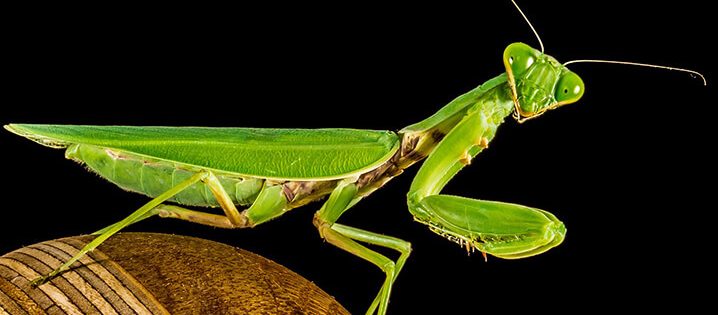The praying mantis (so named because there forearms are folded in a seemingly praying position in their upright posture) are insects of the order Mantodea with over 2,300 species in about 15 families. The largest family of mantis is the mantidae. They primarily live in the temperate and tropical habitats of the world and despite usually being confused with grasshoppers, they are closely related to the Termites and Cockroaches as they all fall within the Dictyoptera superorder.
Anatomy and Life Cycle
Praying Mantises have bulging eyes in their triangular heads supported by flexible necks. Though some are devoid of wings, they possess strong forelegs for catching and gripping prey (they are mainly ambush predators). They also possess a huge leap that makes up for their lack of wings.
They usually live for a year. In cooler habitats, the adults lay eggs in the autumn before dying. Females lay between 10 and 400 eggs which are encapsulated in hard covers and hatch during the spring. Some females eat their mates after mating.
Praying Mantis Facts
- They possess 3D vision and apart from two compound eyes, they also have 3 spare simple eyes in between.
- They are very athletic, leaping with precision and adjusting their movement’s midair to hit specific targets.
- They have mastered camouflage. They look like leaves and sticks of trees. When faced with blackened landscape, some mantises molt to become black. The flower mantises are the most transforming as they change to look like flowers and get unsuspecting preys close to them.
- Like chief carnivores, they like their food alive and fighting.
- Their meals are not restricted to insects, they also feed on some birds and even frogs. In bigger prey, they start their feasting from the brain.
- The word mantis is from the Greek word for prophet as in ancient times, they were believed to have supernatural powers.
- Their mating sessions can take up to three hours, and with all the energy expended, plus the need to take one last bite before taking on the birth process, the females tend to eat up the males after mating. Black widows style.
Economic importance
Mantises are large and voracious eaters. This makes them very beneficial in gardens as they eat pest insects like wasps and beetles. The adults can be caught or the eggs moved into gardens as a healthier alternative to pesticides.


